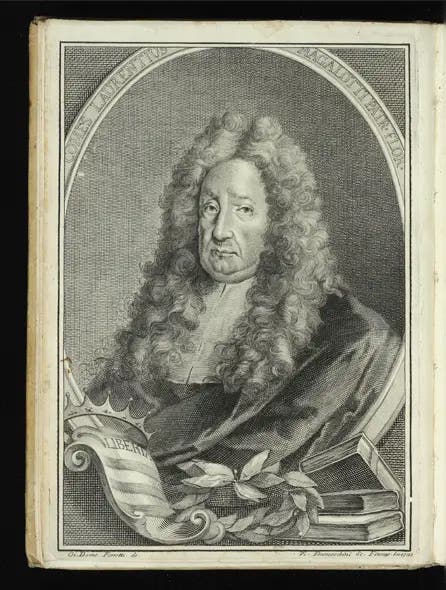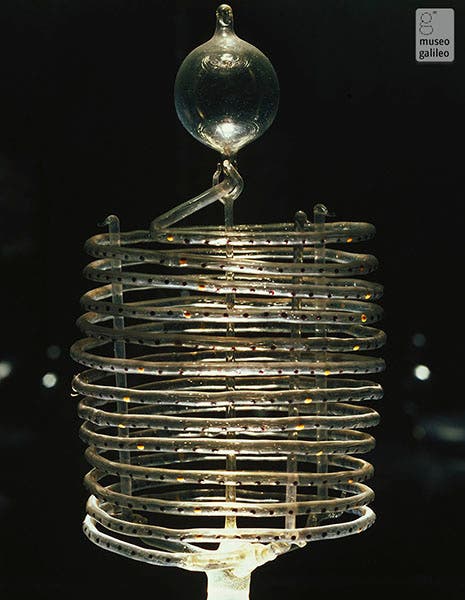Scientist of the Day - Lorenzo Magalotti
Lorenzo Magalotti, an Italian courtier, died on Mar. 4, 1712, at the age of 74. Courtier is no longer a respectable profession, but it certainly was in Renaissance and 17thh-century Italy. Courtiers, as the name indicates, were figures at court, whether the court be that of the Este family at Ferrara, the Gonzaga at Mantua, the Borghese and Chigi in Rom, or the Medici in Florence. As detailed by Baldassare Castiglione, in his influential book, Il Libro del Cortegiano (Book of the Courtier, 1528), a courtier's job was to serve, please, and instruct his Prince. He should be blessed with a native intelligence; an ability to write fluent prose in all the languages of the court; a witty conversationalist and desirable dinner companion; good at fencing; politically astute; and firm but tactful as he kept his prince on the right course. A courtier was the Presidential secretary of the Renaissance, as essential as anyone in maintaining the vitality of the court. It has been argued that Galileo was more courtier than he was astronomer (by Mario Biagioli, in his book, Galileo, Courtier (1993)).
Magalotti served the Medici court in Florence, beginning at a young age. In 1658, when Magalotti came of age, Florence was led by Ferdinando II de' Medici, the Grand Duke of Tuscany, who had ruled since 1621, when he was 11 years old, and who would remain in power until his death in 1670. Ferdinando had a brother, Leopoldo, who was 7 years younger. Both Ferdinando and Leopoldo were interested in natural philosophy (Ferdinando was the patron of Galileo and did his best – in the end unsuccessfully – to protect Galileo from the wrath of Pope Urban VIII in Rome). Ferdinando had little time to pursue science on his own, but Leopoldo, like most siblings at court, had nothing but time, and he took a great interest in natural philosophy, especially the experimental kind, advocated and practiced by Galileo. In 1657 (on June 19, to be precise), Leopoldo convened a half-dozen or so natural philosophers in one of the rooms of the Medici Palace in Florence, and informed them that they were now part of a group that would "do science" the Galilean way, by experimental investigation. These philosophers included Vincenzo Viviani, the future biographer of Galileo, and Giovanni Borelli, the father of biomechanics. They began by re-doing a series of experiments known as the "Torricellian experiments," involving what we would call a barometer (see our posts on Torricelli and Blaise Pascal), and then moved on to thermometry and experiments on heat and cold. The group experimented quite actively and regularly for the next 5 years.
Leopoldo appointed a secretary, who recorded the results of the experiments, and the first secretary either developed other interests or proved unsatisfactory to Leopoldo, for he was replaced in 1660 by Magalotti, who was recommended by Viviani. This proved to be an auspicious move for Magalotti, especially after Leopoldo decided that he wanted to publish a written account of the activities of his "Academy," which Magalotti was to write. The group did not yet have a name, but by the time Magalotti published his book, it was called the Accademia del Cimento, the Cimento Academy. It was in fact the world's first scientific society (the Royal Society of London would not be founded until 1660 or chartered until 1662).
The book Magalotti wrote and published in 1667 was called Saggi di naturali esperienze (Accounts of Natural Experiments). The Saggi is a beautiful small folio, adorned with numerous full-page engravings depicting a variety of experiments. The title page displays the Academy’s emblematic device, with the motto, provando e riprovando (“test and test again”) (fifth image). Our copy is bound in limp vellum. The narrative is intriguing because everything is attributed to the group, and no individuals are mentioned by name. This was by design – Leopoldo’s design. Magalotti, known to be the author, does not appear on the title page, or indeed anywhere else in the book. On instruction from Leopoldo, he also avoided discussion of explanations or causes of experimental results. The experiments were left to explain themselves. If you were an atomist and wanted to explain heat flow by corpuscles, that was fine, but there would be none of that in the book. Like Isaac Newton later, they would “feign no hypotheses.”
The Saggi was not a journal – it recorded the results of ten (really five) years of experiments, and the Cimento Academy had broken up by the time the Saggi appeared in print. But it was the first written account of the activities of a scientific society, and thus enormously influential. Moreover, it was beautifully written, in the Tuscan tongue. Magalotti is often cited as one of the two finest masters of the Tuscan dialect (the other being Galileo), and the two are usually given credit for the fact that Tuscan ultimately became the official language of Italy. The book was often reprinted and translated. We have six editions of the Saggi in the History of Science Collection, including the first edition of 1667 (in Tuscan), the first English edition (1684), and the first Latin edition (1731). Many of the beautiful pieces of glassware made by the academicians still survive in the Museo Galileo in Florence, such as a delicate spiral thermometer, which we see in both an engraving of 1667 (sixth image) and on the Museo Galileo website (seventh image).
The Saggi contains a full-page frontispiece portrait (eighth image). I confess that for many years I assumed it showed Leopoldo, the academy’s patron. But of course, he is just as anonymous as everyone else in the book. It depicts rather Ferdinando II de’ Medici, to whom the Saggi is dedicated. The real Leopoldo (who looked very much like his brother) was later painted by Justus Sustermans, after Leopoldo had become a Cardinal (third image).
William B. Ashworth, Jr., Consultant for the History of Science, Linda Hall Library and Associate Professor emeritus, Department of History, University of Missouri-Kansas City. Comments or corrections are welcome; please direct to ashworthw@umkc.edu.

![A Torricellian tube under a bell jar (left), and another with an air pump attached, engraving in Saggi di naturali esperienze, [by Lorenzo Magalotti], 1667 (Linda Hall Library)](https://assets-us-01.kc-usercontent.com:443/9dd25524-761a-000d-d79f-86a5086d4774/ded209a8-559a-451f-9d21-855a92035f87/magalotti1.jpg?w=385&h=420&auto=format&q=75&fit=crop)
![A Torricellian tube under a bell jar (left), and another with an air pump attached, engraving in Saggi di naturali esperienze, [by Lorenzo Magalotti], 1667 (Linda Hall Library)](https://assets-us-01.kc-usercontent.com:443/9dd25524-761a-000d-d79f-86a5086d4774/956dc332-3da6-4777-a480-60ee94b0d91f/magalotti1.jpg?w=385&h=600&auto=format&q=75&fit=crop)


![Title page, with engraved vignette, Saggi di naturali esperienze, [by Lorenzo Magalotti], 1667 (Linda Hall Library)](https://assets-us-01.kc-usercontent.com:443/9dd25524-761a-000d-d79f-86a5086d4774/fcb94539-6cdb-4b9a-8b5d-1a32716dadb1/magalotti4.jpg?w=429&h=600&auto=format&q=75&fit=crop)
![Title page vignette, detail of fourth image, showing the emblematic device of the Accademia del Cimento, with its motto, provando e riprovando (test and test again), Saggi di naturali esperienze, [by Lorenzo Magalotti], 1667 (Linda Hall Library)](https://assets-us-01.kc-usercontent.com:443/9dd25524-761a-000d-d79f-86a5086d4774/4082b7e7-1c26-44a8-93ea-de8f3094e32f/magalotti5.jpg?w=800&h=551&auto=format&q=75&fit=crop)
![Various apparatus made and used by the Accademia del Cimento, including a delicate spiral thermometer at left center, engraving in Saggi di naturali esperienze, [by Lorenzo Magalotti], 1667 (Linda Hall Library)](https://assets-us-01.kc-usercontent.com:443/9dd25524-761a-000d-d79f-86a5086d4774/af800fe6-d050-4198-bf0a-bd5a0e2baaa4/magalotti6.jpg?w=426&h=600&auto=format&q=75&fit=crop)

![Portrait of Grand Duke Ferdinando II de’ Medici, engraved frontispiece to Saggi di naturali esperienze, [by Lorenzo Magalotti], 1667 (Linda Hall Library)](https://assets-us-01.kc-usercontent.com:443/9dd25524-761a-000d-d79f-86a5086d4774/fe3f4592-eb42-4a3d-a075-4b33cbe3cbb5/magalotti8.jpg?w=429&h=600&auto=format&q=75&fit=crop)




